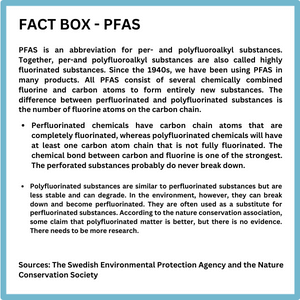When we are out being active, we like clothes and shoes that are waterproof and, at the same time, breathable. To achieve this effect, many manufacturers of outdoor clothing have added so-called PFAS substances to their garments. These water and dirt-repellent chemicals are adequate for their purpose but extremely difficult to degrade in nature and can pose a health hazard to animals and humans. Of course, it feels entirely contradictory to be out enjoying nature while risking contributing to the spread of environmentally hazardous chemicals through our clothes.
After much attention from researchers and the media, many outdoor clothing manufacturers are now phasing out the most long-lasting and hazardous chemicals. But it is essential to be aware of the alternatives!

WHAT IS PFAS?
PFAS (high fluorinated substances) is a collective name for about 4700 water and dirt-repellent chemicals [2]. They are used as impregnation and surface treatment in several products, from food packaging and frying pan to make-up and electronics. Textile and leather impregnation is among the most essential use areas [4], often occurring in outdoor clothing. Like other chemicals in clothing, PFAS substances eventually end up in the environment. When washing, we rinse out the chemicals with the wastewater. In addition, they come loose during use and wear, not least when thrown away [2]. Because we use PFAS in so many different products and materials, they are widespread and are now found everywhere on earth, in our water, animals, and humans.
HIGHLY FLUORINATED SUBSTANCES, WHAT DOES IT MEAN?
Highly fluorinated substances are chemicals made from a chain of carbon atoms with added fluorine. The chemical bond between carbon and fluorine is one of the strongest. Thus, the PFAS materials can be dirt, grease, and water-repellent. Due to the strong bond between carbon and fluorine, PFASs are among the less biodegradable. Unlike other environmental solid toxins such as PCBs and DDT, there are many indications that certain PFASs are impossible to degrade, meaning the more released into the environment, the more it accumulates in nature, animals, and humans. Science shows that some highly fluorinated substances interfere with reproduction, cause liver damage and are also suspected of carcinogens.

PHASE OUT PFAS! – BUT WHAT ARE THE ALTERNATIVES?
Research shows that most people who buy outdoor clothing are only interested in the garment’s water-repellent properties [2], and for water-repellent clothing, there are several alternatives to PFAS.
Many companies that manufacture outdoor clothing are now phasing out the most difficult-to-degrade and environmentally harmful PFAS substances. According to the Swedish Society for Nature Conservation, many manufacturers have set their sights on switching to PFAS-free production by 2020 [1].
There are already alternatives to PFAS on the market today [2]. Membranes in outdoor clothing are replaced from PFAS with plastics such as polyester. The impregnation in outdoor clothing, which often contains PFAS substances, has been replaced by some manufacturers with other substances, such as wax or silicone [1].

But in some cases, other fluorinated alternatives are replaced when we phase out PFAS substances. These alternatives might last as long in the environment as the PFAS substances. Replacing high-fluorinated material with low-fluorinated substances in impregnation has been criticized by Greenpeace, among others. More than 200 researchers have written an appeal, “The Madrid statement”, demanding a stop to all fluorinated substances. They argue that the most common substitutes for phasing out certain PFASs are other PFASs with similar structures [6].
FOR THE CONSUMER, IT CAN BE DIFFICULT TO KNOW IF CLOTHES OR SHOES CONTAIN PFAS
It is not certain that shoes and clothes have a label with information if they contain PFAS. Therefore, ask in the store. If the dealer does not know, they are obliged to find out [7]. In addition, you have the right to know if what you want to buy contains any substances included in the EU’s list of hazardous chemicals, the so-called candidate list ![]()

References
- If you want to impregnate shoes or clothes, use wax or impregnation marked with Good Environmental Choice or the Nordic Ecolabel
- Ask the store staff about PFAS when you buy outdoor clothing. The more people who ask questions about dangerous substances in the stores, the better knowledge the stores will need to acquire about the goods they sell!
- It is always best to buy used clothes, as most PFAS are released into nature during the actual production of the garments.
Sources
- Naturskyddsforeningen.se- GREEN GUIDE – CLOTHES – Best Jacket

- Forskning.se – Water-repellent chemicals in outdoor clothing completely unnecessary

- Naturskyddsforeningen.se – Avoid dangerous chemicals in your clothes

- Kemi.se – waterproof and dirt-repellent fabrics

- Naturvardsverket.se – Organiska miljögifter

- Sverigesnatur.org – Less poison in shell jackets – fluorocarbons are being phased out

- Kemi.se – Tips for a chemical-smart everyday life




